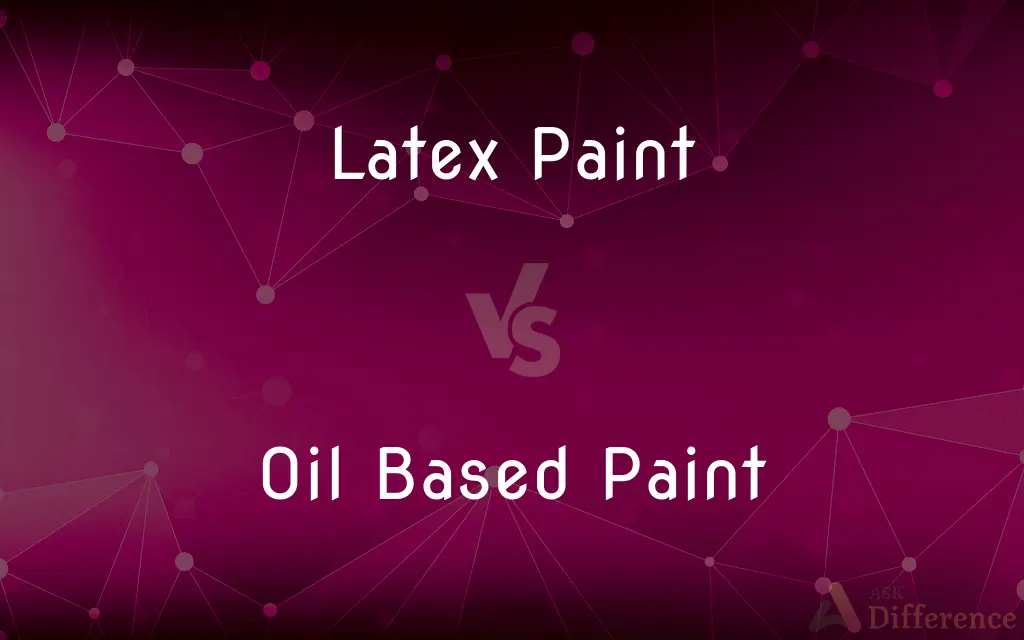Latex Paint vs. Oil Based Paint — What's the Difference?
By Tayyaba Rehman & Urooj Arif — Published on February 5, 2024
Latex paint is water-based, quick-drying, and easier to clean, while oil-based paint is more durable, takes longer to dry, and requires solvents for cleanup.

Difference Between Latex Paint and Oil Based Paint
Table of Contents
ADVERTISEMENT
Key Differences
Latex paint, a water-based paint, is known for its quick drying time and ease of application. It's commonly used in homes due to its low odor and easy clean-up with water. Oil-based paint, on the other hand, is made with oil and has a longer drying time. It's often used for its durability and resistance to wear, making it suitable for high-traffic areas and exteriors.
Latex paint offers good durability and is resistant to fading and chipping, making it a popular choice for walls and ceilings. Its finish can range from matte to high gloss. Oil-based paint is known for its superior durability and resistance to stains, making it ideal for trims, moldings, and doors. It typically provides a smoother, glossier finish compared to latex.
Latex paint is environmentally friendlier, emitting lower levels of volatile organic compounds (VOCs), which are harmful to health and the environment. Oil-based paint contains higher levels of VOCs, contributing to air pollution and potential health risks, requiring careful disposal.
Latex paint is easier to apply and can be cleaned up with soap and water, making it convenient for DIY projects. It's also less prone to yellowing over time. Oil-based paint requires solvents like turpentine for cleanup, can be more challenging to apply, and tends to yellow with age, especially in low-light areas.
Latex paint offers a wide range of vibrant colors and tends to maintain its color better over time due to its resistance to UV rays. Oil-based paint, while also available in various colors, may have a limited range and can fade or yellow, affecting the desired aesthetic over time.
ADVERTISEMENT
Comparison Chart
Base
Water-based
Oil-based
Drying Time
Dries quickly
Takes longer to dry
Cleanup
Easy with soap and water
Requires solvents like turpentine
Durability
Good; less resistant to elements
Superior; highly resistant
Suitable Surfaces
Walls, ceilings
Trims, moldings, doors
Environmental Impact
Low VOCs; eco-friendly
High VOCs; less eco-friendly
Finish
Matte to high gloss
Glossier, smoother finish
Color Retention
Better UV resistance; retains color longer
Prone to yellowing and fading
Application Suitability
Preferred for indoor use
Ideal for exteriors and high-traffic areas
Compare with Definitions
Latex Paint
Latex paint offers a wide range of color options and maintains color fidelity over time.
The vibrant blue latex paint in our kitchen has maintained its hue for years.
Oil Based Paint
Oil-based paint requires specific solvents like turpentine for clean-up.
Cleaning brushes after using oil-based paint required turpentine, unlike water-based paints.
Latex Paint
Latex paint is favored for its easy clean-up with just soap and water.
Cleanup was a breeze after painting our bedroom with latex paint.
Oil Based Paint
Oil-based paint is preferred for its resistance to stains and its glossy finish.
For the trim and doors, oil-based paint was our choice due to its glossy look and stain resistance.
Latex Paint
Latex paint is a water-based, easily applicable paint ideal for interior walls and ceilings.
We used latex paint for our living room because it dries quickly and has low odor.
Oil Based Paint
Oil-based paint is characterized by its longer drying time and higher VOC content.
While painting the exterior, we opted for oil-based paint despite its longer drying time for its resilience.
Latex Paint
Latex paint is known for its eco-friendly properties due to low VOC emissions.
Choosing latex paint was a no-brainer for our eco-conscious home renovation.
Oil Based Paint
Oil-based paint is known for its durability and smooth finish, ideal for surfaces requiring frequent cleaning.
We used oil-based paint on our kitchen cabinets for its durability and ease of cleaning.
Latex Paint
Latex paint is suitable for a variety of surfaces and is often used for DIY projects.
For our DIY furniture project, we used latex paint for its versatility.
Oil Based Paint
Oil-based paint tends to yellow over time, especially in low-light areas.
The oil-based paint in our hallway has yellowed over the years, needing a repaint.
Common Curiosities
What is oil-based paint?
Oil-based paint is a durable paint with an oil base, known for its glossy finish and suitability for high-traffic areas.
Is oil-based paint more durable than latex paint?
Yes, oil-based paint is generally more durable, making it ideal for surfaces that require frequent cleaning.
How long does latex paint take to dry?
Latex paint typically dries to the touch within an hour, but it takes up to 4 weeks to fully cure.
Is latex paint environmentally friendly?
Latex paint is more environmentally friendly due to its low VOC content.
Does oil-based paint yellow over time?
Yes, oil-based paint can yellow over time, especially in areas with low natural light.
How long does oil-based paint take to dry?
Oil-based paint takes longer to dry, usually 6-8 hours to touch dry and up to 24 hours to recoat.
What is latex paint?
Latex paint is a water-based paint known for its quick drying time and ease of use, commonly used for interior walls and ceilings.
Can I clean latex paint brushes with water?
Yes, brushes used with latex paint can be cleaned with soap and water.
Can latex paint be used over oil-based paint?
Yes, but only after proper surface preparation, including sanding and priming.
What should I use to clean oil-based paint brushes?
Brushes used with oil-based paint should be cleaned with a solvent like turpentine.
Does oil-based paint emit more VOCs than latex paint?
Yes, oil-based paint typically emits higher levels of VOCs compared to latex paint.
Can latex paint be used on metal surfaces?
Latex paint can be used on metal, but it requires proper priming to ensure adhesion.
Can latex paint be applied in cold weather?
Latex paint requires temperatures above 50°F for proper application and curing.
Is oil-based paint suitable for all interior surfaces?
While oil-based paint can be used on most interior surfaces, its strong odor and longer drying time may make it less suitable for some indoor applications.
Is oil-based paint better for outdoor use?
Oil-based paint is often preferred for outdoor use due to its resilience to the elements.
Share Your Discovery

Previous Comparison
Tomatoes vs. Cherry Tomatoes
Next Comparison
HP Envy Desktop vs. HP Pavilion DesktopAuthor Spotlight
Written by
Tayyaba RehmanTayyaba Rehman is a distinguished writer, currently serving as a primary contributor to askdifference.com. As a researcher in semantics and etymology, Tayyaba's passion for the complexity of languages and their distinctions has found a perfect home on the platform. Tayyaba delves into the intricacies of language, distinguishing between commonly confused words and phrases, thereby providing clarity for readers worldwide.
Co-written by
Urooj ArifUrooj is a skilled content writer at Ask Difference, known for her exceptional ability to simplify complex topics into engaging and informative content. With a passion for research and a flair for clear, concise writing, she consistently delivers articles that resonate with our diverse audience.













































